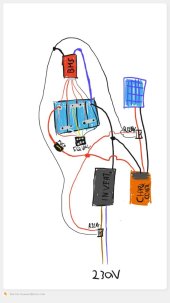Hello everyone, since a few days I have mounted my PV system, unfortunately during the first tests I found a big problem, the bms disconnects the inverter after the load is on for a few minutes, looking at the values on the app (SMART BMS) just before the bms disconnection I can't find any values that can suggest me the reason for the disconnection, the temperature is okay, the battery and cell volts are in the right ranges, and the difference in volts between cells is not excessive, also the bms disconnects for a few seconds and then reattaches the inverter, which with the load connected turns off again after a few minutes and so on in a loop
the minutes before disconnection varies depending on the load,
for an 1800w load the disconnection occurs after 2 minutes, while for a 1250w load the disconnection occurs after about 40 min
I tried to figure out what the problem is but nothing, I can't find the solution, I tried to read the errors via Bluetooth from the app (SMART BMS) but it tells me there are no errors and fails to send the email
my setup:
BMS: Daly BMS ,12v, lifepo4, 30A
Equalizer: active equalizer 4s lifepo4 5A
Charge controller: POWMR MPPT 60A
Inverter: Vevor 12v Pure Wave 230v 2500W - 5000W
Batteries: 4 LifePo4 3.2v battery 280h Discharge/charge current 0.5C Max 1C REPT
IMPORTANT!!!
following a youtuber's video, I have using a small BMS used as a relay, i.e. the inverter and charge controller are connected directly to the battery interrupted though by relays controlled by the bms, i.e. the BMS sees no current in and no current out except for the negligible one from the two relays, of course there are also fuses to control overcurrents, this is done to not overheat the
BMS with large currents and to save money in buying a small BMS instead of a large one.
Has anyone had the same problem or can help me? Thanks in advance
PS: please excuse me for my English
the minutes before disconnection varies depending on the load,
for an 1800w load the disconnection occurs after 2 minutes, while for a 1250w load the disconnection occurs after about 40 min
I tried to figure out what the problem is but nothing, I can't find the solution, I tried to read the errors via Bluetooth from the app (SMART BMS) but it tells me there are no errors and fails to send the email
my setup:
BMS: Daly BMS ,12v, lifepo4, 30A
Equalizer: active equalizer 4s lifepo4 5A
Charge controller: POWMR MPPT 60A
Inverter: Vevor 12v Pure Wave 230v 2500W - 5000W
Batteries: 4 LifePo4 3.2v battery 280h Discharge/charge current 0.5C Max 1C REPT
IMPORTANT!!!
following a youtuber's video, I have using a small BMS used as a relay, i.e. the inverter and charge controller are connected directly to the battery interrupted though by relays controlled by the bms, i.e. the BMS sees no current in and no current out except for the negligible one from the two relays, of course there are also fuses to control overcurrents, this is done to not overheat the
BMS with large currents and to save money in buying a small BMS instead of a large one.
Has anyone had the same problem or can help me? Thanks in advance
PS: please excuse me for my English




